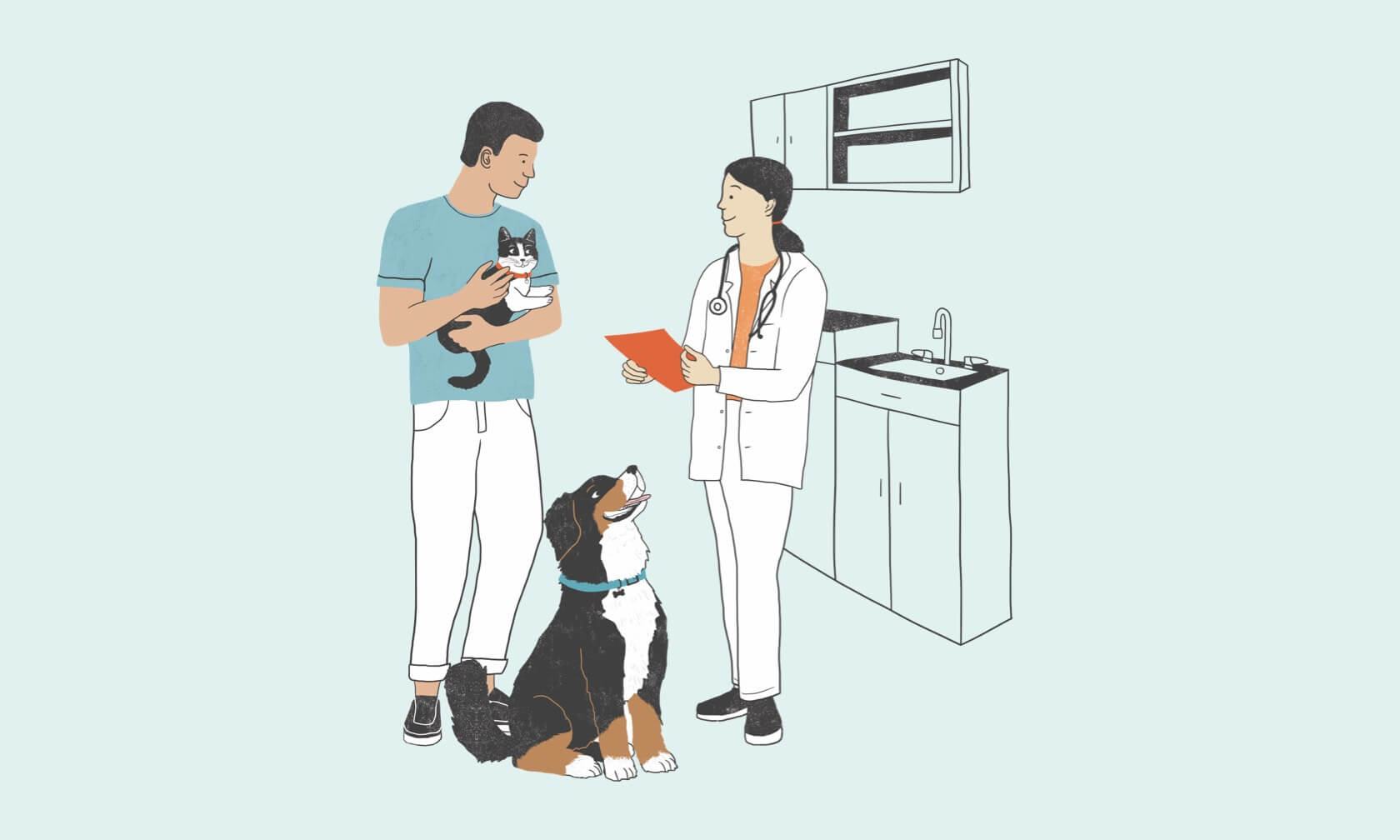Mange has a reputation for only occurring in homeless or abandoned dogs, but the reality is any dog can be affected. Understanding what mange is, how dogs can get it, and how it presents itself is beneficial for your dog and you.
Types of Mange in Dogs
Most animals, including humans, have a natural mite population on their skin. You’re unaware of their presence on your dog (and yourself) because they are microscopic or barely visible to the naked eye.
Mange describes the microscopic mites invading and infesting your dog's skin, causing disease. Your dog can be affected by three types of mange.
- Demodectic mange. This type of mange is caused by demodex canis mites residing in the hair follicles and oil glands of the skin. Though it's the most common form of mange in dogs, it is not contagious to other dogs or people. It's also referred to as demodex or red mange.
- Sarcoptic mange. This type, also known as scabies, is caused by the microscopic sarcoptes scabiei var canis, living just under the skin's surface. It's highly contagious to other animals and people.
- Otodectic mange. This contagious mange, also called ear mites, is caused by otodectes cynotis mites. They are hardly visible to the naked eye. While these mites are generally found deep in the external ear canal, they can sometimes be found on the body.
How Dogs Get Mange
A dog's healthy, normal-functioning immune system can keep certain mites from becoming problematic by suppressing their population. In other cases, avoiding certain situations can help prevent mange.
- Demodectic mange. All dogs have small numbers of these mites living in their hair follicles and sebaceous (oil) glands. They generally cause no issues if the dog's immune system functions properly. The number of mites rapidly increases when the immune system is immature (as with puppies) or compromised due to underlying medical issues or drugs in adult dogs. This results in an inflammatory parasitic skin disease. While not completely understood, some dogs have more demodex canis mites than others. This increased number of mites causes inflammation of the skin and hair loss.
There are 3 forms of demodicosis: localized, juvenile-onset generalized, and adult-onset generalized. The localized form is usually seen in dogs less 12 months old and most cases resolve on their own.
Canine juvenile generalized demodectic mange is caused by a genetic predisposition that results in mites increasing excessively. If one dog is affected in a litter, others may also be affected. Affected dogs should not be bred due to this genetic defect. Parent dogs should not be bred again if any offspring are diagnosed with demodex. Juvenile onset demodectic mange occurs most commonly in dogs 18 months or younger.
Adult onset occurs in dogs over eighteen months of age. Since an underlying disease can be the cause of immunosuppression, a detailed physical examination and diagnostic workup must be performed.
- Sarcoptic mange. These highly contagious mites require a host to feed on. Dogs can become infected by direct contact with other infected dogs and through shared bedding. People can become infected by close contact with infected dogs. The good news is that it doesn't thrive on non-canine hosts.
- Otodectic mange. Dogs become infected with otodectes cynotis mites by close contact with other infected animals (i.e., dogs, cats, rabbits, and ferrets) through social interactions such as playing or sleeping together. Dogs can also become infected through shared bedding since the mite can survive for a limited time in the environment. This type of mange is more common among puppies than adult dogs.
Symptoms of Mange in Dogs
Symptoms vary based on the type of mange your dog has.
- Demodectic mange. Unlike other forms of mange, dogs don't tend to be very itchy with demodex when it first presents. The symptoms include isolated areas with red and scaly skin, as well as hair loss. Symptoms typically start in patches on the face (like around the eyes and lips) and forelimbs. However, other areas can be affected. Localized demodectic mange means fewer than five patches are noted and the lesions are 2.5 cm or less. Generalized demodectic mange is the term when more than five lesions are greater than 2.5 cm and/or the paws are affected. With this form, dogs often lose most, if not all, of their hair and their skin may be red, swollen, scaling, and crusted. When the mange is generalized, dogs can get secondary bacterial and yeast infections on the skin and ears. Some symptoms include:
- Hair loss
- Red, inflamed skin
- Itching and scratching
- Flaky, scaly skin
- Sores
- Odor
- Change in skin texture
- Sarcoptic mange. While some dogs may not show signs of sarcoptic mange, extreme itching the most common symptom in most affected dogs. Severe itching can be caused by only a few mites burrowing under the skin. Other symptoms include hair loss, licking or chewing on the skin, redness, and rash. Advanced cases may see skin thickening, enlarged lymph nodes, and weight loss. Symptoms usually start on the belly, chest, ears, elbows, and hocks.
- Otodectic mange. These mites can cause ear disease and infection. The clinical signs will vary based on the severity of the infestation of mites. Symptoms may include:
- Scratching at the ears due to extreme itchiness
- Head shaking
- Ear discharge that is crusty or dark and waxy
- Hair loss
- Red, inflamed, or irritated ears
- Crusty rash on the skin surrounding the ear as well as the ear itself
- Aural hematoma (a blood-filled swelling of the ear flap)
- Hair loss in other areas of the body
- Skin irritation on other parts of the body, especially the head and neck
Treating Mange in Dogs
Treatment of mange depends on the type and any secondary issues that develop due to the infestation. Your veterinarian will discuss your options with you.
- Demodectic mange. The localized form usually resolves spontaneously, but topical medications may be recommended. It typically involves oral and topical medications to control the mites and treat secondary skin and ear infections.
Adult dogs that develop demodectic mange may require treatment for underlying medical conditions that weakened their immune system leading to the mange. It is not uncommon for dogs to relapse following treatment of the generalized form. In some instances, demodectic mange is not curable and lifelong treatment is needed.
- Sarcoptic mange. Treatment is usually topical or oral consisting of medications to kills the mites, relief the itch, and treat secondary skin infections. Before topical treatments, it may be recommended that your dog is bathed in a medicated shampoo and moisturizing conditioner. Since sarcoptic mange is contagious to animals and people, you should isolate your dog from other pets and as many people as possible. Additionally, you must wear gloves when handling your dog. Make sure to diligently clean and disinfect all surfaces and items your dog comes into contact within your home.
- Otodectic mange. Several topical ear medications are effective in eliminating ear mites. Medications may also be necessary to treat skin and ear infections. If your dog develops an aural hematoma, this will need to be treated. While medical management can be performed (repeatedly draining the hematoma and starting oral anti-inflammatory medications), surgery is the quickest and most effective way to treat aural hematomas. All pets in the household should be treated for ear mites even if they are not showing symptoms.
ZPC-02573
Immunology and pathogenesis of canine demodicosis. National Library of Medicine. https://pubmed.ncbi.nlm.nih.gov/24910252/. Accessed April 10, 2023.
Updates on the Management of Canine Demodicosis. Today’s Veterinary Practice. https://todaysveterinarypractice.com/dermatology/dermatology-detailsupdates-management-canine-demodicosis/. Accessed April 10, 2023.



